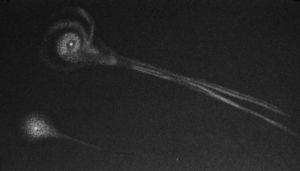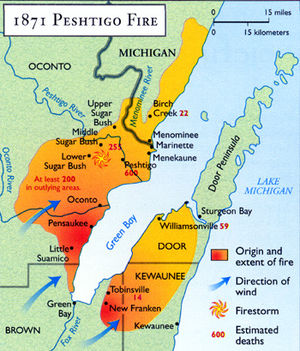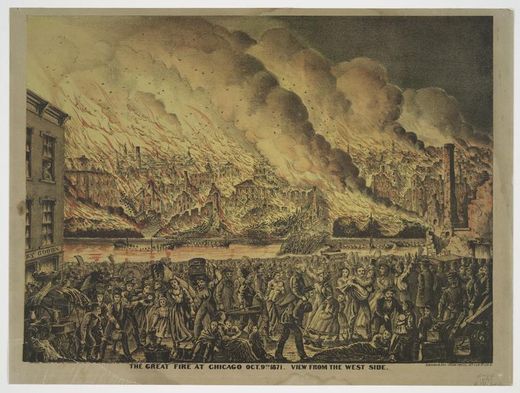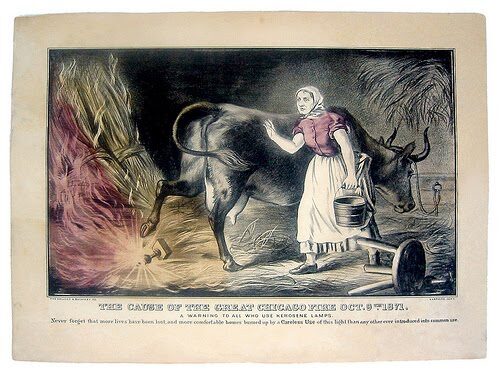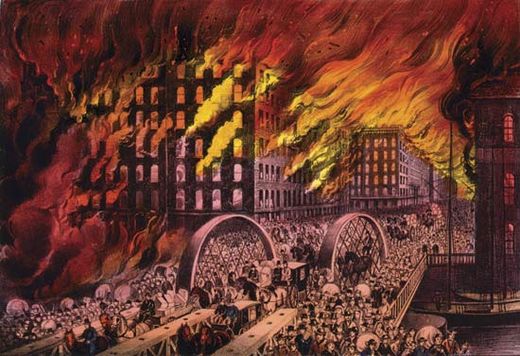This has always been one of those amazing stories from history, as "Mrs. O'Leary's cow" did not start a fire that destroyed Chicago. A firestorm from the sky caused the fire in Chicago, Wisconsin and other parts of the Mid-West. So was it a comet? You decide. This is an excerpt of the article. You can read the entirety here.
Let's back up just a minute here, to 1826. In 1826, comet 3D/Biela was discovered by Wilhelm von Biela. It has become known as Comet Biela or Biela's Comet. This comet had been first seen in 1772 by Charles Messier and again in 1805 by Jean-Louis Pons. It was von Biela who discovered it in its 1826 perihelion approach (on February 27) and calculated its orbit, discovering it to be periodic with a period of 6.6 years which is why it was named after him and not Messier or Pons. It was only the third comet (at the time) found to be periodic, after the famous comets Halley and Encke. French astronomer M. Damoiseau subsequently calculated its path, and announced that on its next return the comet would cross the orbit of the earth, within twenty thousand miles of its track, and about one month before the earth would arrive at the same spot!
When the comet came in 1832, the earth did, indeed, miss it by one month. It returned again in 1839 and 1846. In its 1846 appearance, the comet was observed to have broken up into two pieces. It was observed again in 1852 with the two parts being 1.5 million miles apart. Each part had a head and tail of its own.
The comet did not come in 1852, 1859, or 1866. The Edinburgh Review notes about this strange state of affairs:
Is that all there is to that?
Maybe not.
As it happens, on Sunday, the 8th of October, in the year 1871, at half past nine o'clock in the evening, events occurred which caused the death of hundreds of human beings, and the destruction of vast amounts of property, across three different States of the American Union, sending millions of people into fits of the wildest alarm and terror. The following passages are extracted from the History of the Great Conflagration, Sheahan & Upton, Chicago 1871. [source]
Let's back up just a minute here, to 1826. In 1826, comet 3D/Biela was discovered by Wilhelm von Biela. It has become known as Comet Biela or Biela's Comet. This comet had been first seen in 1772 by Charles Messier and again in 1805 by Jean-Louis Pons. It was von Biela who discovered it in its 1826 perihelion approach (on February 27) and calculated its orbit, discovering it to be periodic with a period of 6.6 years which is why it was named after him and not Messier or Pons. It was only the third comet (at the time) found to be periodic, after the famous comets Halley and Encke. French astronomer M. Damoiseau subsequently calculated its path, and announced that on its next return the comet would cross the orbit of the earth, within twenty thousand miles of its track, and about one month before the earth would arrive at the same spot!
When the comet came in 1832, the earth did, indeed, miss it by one month. It returned again in 1839 and 1846. In its 1846 appearance, the comet was observed to have broken up into two pieces. It was observed again in 1852 with the two parts being 1.5 million miles apart. Each part had a head and tail of its own.
The comet did not come in 1852, 1859, or 1866. The Edinburgh Review notes about this strange state of affairs:
The puzzled astronomers were left in a state of tantalizing uncertainty as to what had become of it. At the beginning of the year 1866 this feeling of bewilderment gained expression in the Annual Report of the Council of the Royal Astronomical Society. The matter continued, nevertheless, in the same state of provoking uncertainty for another six years. The third period of the perihelion passage had then passed, and nothing had been seen of the missing luminary. But on the night of November 27, 1872, night-watchers were startled by a sudden and a very magnificent display of falling stars or meteors, of which there had been no previous forecast... [source]The meteors were radiating from the part of the sky where the comet had been expected to cross in September. In other words, the trajectory was the same, and the earth intersected it, but the velocity was somewhat altered. The American Journal of Science said they fell like snowflakes. Professor Olmstead, a mathematician at Yale University estimated 34,640 shooting stars per hour. The New York Journal of Commerce wrote that no philosopher or scholar has ever recorded an event like this. These meteors became known as the Andromedids or "Bielids" and it seems apparent that they indicated the death of the comet. The meteors were seen again on subsequent occasions for the rest of the 19th century, but have now faded away.
Is that all there is to that?
Maybe not.
As it happens, on Sunday, the 8th of October, in the year 1871, at half past nine o'clock in the evening, events occurred which caused the death of hundreds of human beings, and the destruction of vast amounts of property, across three different States of the American Union, sending millions of people into fits of the wildest alarm and terror. The following passages are extracted from the History of the Great Conflagration, Sheahan & Upton, Chicago 1871. [source]
The summer of 1871 had been excessively dry; the moisture seemed to be evaporated out of the air; and on the Sunday above named the atmospheric conditions all through the Northwest were of the most peculiar character. The writer was living at the time in Minnesota, hundreds of miles from the scene of the disasters, and he can never forget the condition of things. There was a parched, combustible, inflammable, furnace-like feeling in the air, that was really alarming. It felt as if there were needed but a match, a spark, to cause a world-wide explosion. It was weird and unnatural. I have never seen nor felt anything like it before or since. Those who experienced it will bear me out in these statements.
At that hour, half past nine o'clock in the evening, at apparently the same moment, at points hundreds of miles apart, in three different States, Wisconsin, Michigan, and Illinois, fires of the most peculiar and devastating kind broke out, so far as we know, by spontaneous combustion.
In Wisconsin, on its eastern borders, in a heavily timbered country, near Lake Michigan, a region embracing four hundred square miles, extending north from Brown County, and containing Peshtigo, Manistee, Holland, and numerous villages on the shores of Green Bay, was swept bare by an absolute whirlwind of flame. There were seven hundred and fifty people killed outright, besides great numbers of the wounded, maimed, and burned, who died afterward. More than three million dollars' worth of property was destroyed. (pp 393, 394, etc.)
"At sundown there was a lull in the wind and comparative stillness. For two hours there were no signs of danger; but at a few minutes after nine o'clock, and by a singular coincidence, precisely the time at which the Chicago fire commenced, the people of the village heard a terrible roar. It was that of a tornado, crushing through the forests. Instantly the heavens were illuminated with a terrible glare. The sky, which had been so dark a moment before, burst into clouds of flame.
A spectator of the terrible scene says the fire did not come upon them gradually from burning trees and other objects to the windward, but the first notice they had of it was a whirlwind of flame in great clouds from above the tops of the trees, which fell upon and entirely enveloped everything. The poor people inhaled it, or the intensely hot air, and fell down dead. This is verified by the appearance of many of the corpses. They were found dead in the roads and open spaces, where there were no visible marks of fire near by, with not a trace of burning upon their bodies or clothing. At the Sugar Bush, which is an extended clearing, in some places four miles in width, corpses were found in the open road, between fences only slightly burned. No mark of fire was upon them; they lay there as if asleep. This phenomenon seems to explain the fact that so many were killed in compact masses. They seemed to have huddled together, in what were evidently regarded at the moment the safest places, far away from buildings, trees, or other inflammable material, and there to have died together. (p. 372)
Another spectator says:
"Much has been said of the intense heat of the fires which destroyed Peshtigo, Menekaune, Williamsonville, etc., but all that has been said can give the stranger but a faint conception of the reality. The heat has been compared to that engendered by a flame concentrated on an object by a blow-pipe; but even that would not account for some of the phenomena. For instance, we have in our possession a copper cent taken from the pocket of a dead man in the Peshtigo Sugar Bush, which will illustrate our point. This cent has been partially fused, but still retains its round form, and the inscription upon it is legible. Others, in the same pocket, were partially melted, and yet the clothing and the body of the man were not even singed. We do not know in what way to account for this, unless, as is asserted by some, the tornado and fire were accompanied by electrical phenomena" (373).
"It is the universal testimony that the prevailing idea among the people was, that the last day had come. Accustomed as they were to fire, nothing like this had ever been known. They could give no other interpretation to this ominous roar, this bursting of the sky with flame, and this dropping down of fire out of the very heavens, consuming instantly everything it touched.
"No two give a like description of the great tornado as it smote and devoured the village. It seemed as if 'the fiery fiends of hell had been loosened,' says one. 'It came in great sheeted flames from heaven,' says another. 'There was a pitiless rain of fire and *sand*.' 'The atmosphere was all afire.' Some speak of 'great balls of fire unrolling and shooting forth in streams.' The fire leaped over roofs and trees, and ignited whole streets at once. No one could stand before the blast. It was a race with death, above, behind, and before them" (Ibid 374).
A civil engineer, doing business in Peshtigo, says:
"The heat increased so rapidly, as things got well afire, that, when about four hundred feet from the bridge and the nearest building, I was obliged to lie down behind a log that was aground in about two feet of water, and by going under water now and then, and holding my head close to the water behind the log, I managed to breathe. There were a dozen others behind the same log. If I had succeeded in crossing the river and gone among the buildings on the other side, probably I should have been lost, as many were."
In Michigan, one Allison Weaver, near Port Huron, determined to remain, to protect, if possible, some mill-property of which he had charge. He knew the fire was coming, and dug himself a shallow well or pit, made a thick plank cover to place over it, and thus prepared to bide the conflagration. I quote:
"He filled it nearly full of water, and took care to saturate the ground around it for a distance of several rods. Going to the mill, he dragged out a four-inch plank, sawed it in two, and saw that the parts tightly covered the mouth of the little well. 'I calculated it would be touch and go,' said he, 'but it was the best I could do.' At midnight he had everything arranged, and the roaring then was awful to hear. The clearing was ten to twelve acres in extent, and Weaver says that, for two hours before the fire reached him, there was a constant flight across the ground of small animals. As he rested a moment from giving the house another wetting down, a horse dashed into the opening at full speed and made for the house. Weaver could see him tremble and shake with excitement and terror, and felt a pity for him. After a moment, the animal gave utterance to a snort of dismay, ran two or three times around the house, and then shot off into the woods like a rocket."
"Not long after this the fire came. Weaver stood by his well, ready for the emergency, yet curious to see the breaking-in of the flames. The roaring increased in volume, the air became oppressive, a cloud of dust and cinders came showering down, and he could see the flame through the trees. It did not run along the ground, or leap from tree to tree, but it came on like a tornado, a sheet of flame reaching from the earth to the tops of the trees. As it struck the clearing he jumped into his well, and closed over the planks. He could no longer see, but he could hear. He says that the flames made no halt whatever, or ceased their roaring for an instant, but he hardly got the opening closed before the house and mill were burning tinder, and both were down in five minutes. The smoke came down upon him powerfully, and his den was so hot he could hardly breathe.
"He knew that the planks above him were on fire, but, remembering their thickness, he waited till the roaring of the flames had died away, and then with his head and hands turned them over and put our the fire by dashing up water with his hands. Although it was a cold night, and the water had at first chilled him, the heat gradually warmed him up until he felt quite comfortable. He remained in his den until daylight, frequently turning over the planks and putting out the fire, and then the worst had passed. The earth around was on fire in spots, house and mill were gone, leaves, brush, and logs were swept clean away as if shaved off and swept with a broom, and nothing but soot and ashes were to be seen" (390).
In Wisconsin, at Williamson's Mills, there was a large but shallow well on the premises belonging to a Mr. Boorman. The people, when cut off by the flames and wild with terror, and thinking they would find safety in the water, leaped into this well.
"The relentless fury of the flames drove them pell-mell into the pit, to struggle with each other and die - some by drowning, and others by fire and suffocation. None escaped. Thirty-two bodies were found there. They were in every imaginable position; but the contortions of their limbs and the agonizing expressions of their faces told the awful tale". (386)
James B. Clark, of Detroit, who was at Uniontown, Wisconsin, writes:
"The fire suddenly made a rush, like the flash of a train of gunpowder, and swept in the shape of a crescent around the settlement. It is almost impossible to conceive the frightful rapidity of the advance of the flames. The rushing fire seemed to eat up and annihilate the trees."
They saw a black mass coming toward them from the wall of flame:
"It was a stampede of cattle and horses thundering toward us, bellowing, moaning, and neighing as they galloped on; rushing with fearful speed, their eyeballs dilated and glaring with terror, and every motion betokening delirium of fright. Some had been badly burned, and must have plunged through a long space of flame in the desperate effort to escape.
Following considerably behind came a solitary horse, panting and snorting and nearly exhausted. He was saddled and bridled, and, as we first thought, had a bag lashed to his back. As he came up we were startled at the sight of a young lad lying fallen over the animal's neck, the bridle wound around his hands, and the mane being clinched by the fingers. Little effort was needed to stop the jaded horse, and at once release the helpless boy. He was taken into the house, and all that we could do was done; but he had inhaled the smoke, and was seemingly dying. Some time elapsed and he revived enough to speak. He told his name - Patrick Byrnes - and said: 'Father and mother and the children got into the wagon. I don't know what became of them. Everything is burned up. I am dying. Oh! Is hell any worse than this?'" (383)
When we leave Wisconsin and pass about two hundred and fifty miles eastward, over Lake Michigan and across the whole width of the State of Michigan, we find much the same condition of things, but not so terrible in the loss of life. Fully fifteen thousand people were rendered homeless by the fires; and their food, clothing, crops, horses, and cattle were destroyed. Of these five to six thousand were burned out the same night that the fires broke out in Chicago and Wisconsin. The total destruction of property exceeded one million dollars; not only villages and cities, but whole townships, were swept bare.
But it is to Chicago we must turn for the most extraordinary results of this atmospheric disturbance. It is needless to tell the story in detail. The world knows it by heart. I have only space to refer to one or two points...
The fire was spontaneous. The story of Mrs. O'Leary's cow having started the conflagration by kicking over a lantern was proved to be false. It was the access of gas from the tail of Biela's comet that burned up Chicago!
The fire-marshal testified: "I felt it in my bones that we were going to have a burn." He says, speaking of O'Leary's barn:
"We got the fire under control, and it would not have gone farther; but the next thing I knew they came and told me that St. Paul's church, about two squares north, was on fire". (163)
They checked the church-fire, but - "The next thing I knew the fire was in Bateham's planing-mill."
A writer in the New York Evening Post says he saw in Chicago "buildings far beyond the line of fire, and in no contact with it, burst into flames from the interior."
It must not be forgotten that the fall of 1871 was marked by extraordinary conflagrations in regions widely separated. On the 8th of October, the same day the Wisconsin, Michigan, and Chicago fires broke out, the States of Iowa, Minnesota, Indiana, and Illinois were severely devastated by prairie-fires; while terrible fires raged on the Alleghenies, the Sierras of the Pacific coast, and the Rocky Mountains, and in the region of the Red River of the North.
The Annual Record of Science and Industry for 1876, page 84, says:
"For weeks before and after the great fire in Chicago in 1872, great areas of forest and prairie-land, both in the United States and the British Provinces, were on fire."
The flames that consumed a great part of Chicago were of an unusual character and produced extraordinary effects. They absolutely melted the hardest building-stone, which had previously been considered fire-proof. Iron, glass, granite, were fused and run together into grotesque conglomerates, as if they had been put through a blast-furnace. No kind of material could stand its breath for a moment.
